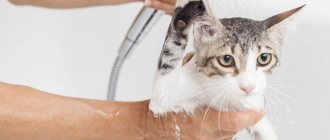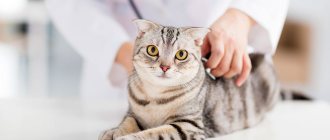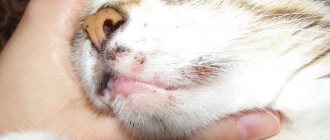Kidney tissue is not capable of recovery, and clinical symptoms appear when more than 2/3 of the organ fails.
The main task of the cat owner and veterinarian is to stop the increase in destructive processes and prolong the life of the pet while feeling satisfactory. This publication tells you how to do this.
Factors influencing the development of kidney disease in cats
Many factors influence the functioning of the excretory organs.
The unfavorable ones include the following:
- Unsatisfactory nutrition: protein overfeeding, imbalance in vitamins and minerals, consumption of food unusual for cats, containing spices, sugar, table salt, and also smoked or fried.
- Unfavorable living conditions: drafts, dampness, dirty tray.
- Viral and bacterial infections.
- Chronic diseases: cystitis, urolithiasis, pancreatitis; hepatitis, diabetes mellitus, gingivitis, pyometra.
- Poisoning with toxic substances or medications.
- Worm infestation.
- Allergy.
- Poor water quality.
- Genetic abnormalities. They end up dying at an early age.
- Predisposition to kidney disease in certain breeds.
Treatment
An animal whose kidney size has changed receives Hill's food. The veterinarian prescribes Almagel Neo 0.5 ml per 1 kg of body weight 2 times a day. The cat is given the supplement Ipaquitina 1 g per 5 kg of weight 2 times a day with food.
The course of therapy is 3 months.
As a result, the pet’s clinical condition improves:
- appetite appears;
- thirst and vomiting disappear;
- the number of urinations does not exceed 3 times a day.
The following drugs are used to treat animals:
- ACEI;
- AG II receptor blockers;
- Aliskiren tablets 150 or 300 mg/kg once every 24 hours.
A pet is prescribed the drug Telmisartan in an amount of 1-2 mg/kg 1 time per day.
Amlodipine 0.625 mg, Atenolol and Metoprolol 1-2 mg/kg body weight are used 2 times a day for a long time.
To stabilize the size of the kidneys in chronic renal failure, dietary products containing phosphorus are used: Chitosan, Lantarenol.
Forecast of the course of diseases
The outcome of the disease is determined by the rate of development of the disease; the risk of death with chronic renal failure increases if the cat has enlarged kidneys, and the first symptoms of the disease appear at an early age.
The course of polycystic disease is aggravated by uncontrolled hypertension, the appearance of blood in urine, and bacterial infections of the urinary system.
Kidney diseases (acute and chronic) affect the filtration system and lead to an autoimmune process that shortens the life expectancy of a pet.
The prognosis for enlarged kidneys in a cat is unfavorable if the cause of the pathological condition is a malignant tumor.
The doctor carries out symptomatic therapy to prolong the life of the animal. Anomalies in the development of the urinary organ, such as bifid kidney, ectopia or polycystic disease, are often associated with urinary tract infection.
A pregnant cat has an unfavorable prognosis: mortality and the birth of immature kittens increases. An enlarged kidney located in the pelvis leads to abnormal position of the fetus and prevents spontaneous childbirth.
An animal with an enlarged single kidney often develops an infection, accompanied by pain, fever, and anuria.
Causes
There are many causes of nephritis, but the most common signs of the disease in cats are:
- Incorrect use of medications.
- Poisoning with household chemicals.
- Poor nutrition or poisoning from poor quality food.
- Damage to the body by helminthic infestation.
- Hypothermia, injuries, etc.
© shutterstock
Note. Most often among animals, cats are susceptible to nephritis; for example, in dogs this disease appears 3 times less often.
Causes of pathological processes
There are many reasons for the development of kidney disease in cats, but most often these are shortcomings on the part of the owners associated with improper care or poor living conditions.
Possible causes of kidney disease in cats:
- allergy;
- infectious diseases;
- food or poison poisoning;
- exposure to toxic substances or microbes on the animal’s body;
- injuries;
- parasites;
- age from 8 years;
- genetic predisposition;
- gastrointestinal diseases;
- bronchopneumonia;
- the predominance of meat and fish in the diet (exceeding the level of phosphorus and protein);
- weight imbalances up or down;
- lack of fluid intake;
- drug overdose;
- drinking poor-quality tap water;
- excessively salty or sweet foods;
- minimal physical activity;
- hypothermia, drafts;
- diseases of the gums and teeth;
- urinary retention.
Due to the fact that kidney diseases are diagnosed in late stages, determining the exact cause of their occurrence is difficult, and in some cases, almost impossible.
Common feline kidney diseases
Inflammatory kidney diseases are called nephritis.
The most common types that develop in cats are:
- Pyelonephritis - purulent processes in the parenchyma and pelvis under the influence of pathogenic bacteria;
- Nephrosclerosis : replacement of parenchyma with connective tissue.
- Hydronephrosis : expansion of the pelvis, in which urine is retained and compresses the parenchyma, which eventually atrophies;
- Chronic renal failure (CRF). In which the organ ceases to perform its functions;
- Glomerulonephritis: non-infectious damage to the filtering glomeruli;
- Polycystic disease is the congenital presence of empty cavities in the parenchyma that are constantly increasing;
- Amyloidosis is a genetic abnormality characterized by the replacement of parenchyma with starch-like substances (amylum).
Be sure to read: Tripelphosphates and struvite in a cat’s urine: what is it, normal and abnormalities, reasons for the increase, treatment
Nephritis can occur in acute and chronic form with periodic exacerbations.
The most common pathologies
In most cases, the cause of kidney pathologies is difficult to determine. The most common causes are infections, systemic diseases, injuries, poisoning, and unbalanced nutrition. All cats over 7 years of age are at risk.
The most common kidney diseases are nephritis - pyelonephritis, glomeronephritis, hydronephritis. These are inflammatory processes of different localization and different bacterial nature.
Concretions (stones) can form in the renal ducts and block the ducts, which leads to urolithiasis and enlarged kidneys in the cat. This disease is most typical for older castrated cats that have been fed dry food and fish for life. Shifts of stones are painful and occur in attacks; there are often traces of blood in the urine.
The most severe pathology is the syndrome of impairment of all renal functions. It often leads to chronic renal failure (CRF), which has a poor prognosis. With this pathology, the nephrons are replaced by connective tissue, and the cat’s kidneys are enlarged. It can be cured, although it is very difficult. More often it is only possible to stabilize the animal, provide supportive therapy and prolong life.
general information
In cats, like all mammals, a pair of kidneys is located in the abdominal cavity in the area of the lumbar spine. These bean-shaped organs have a complex structure, the structural unit of which is the nephron. It is in these glomeruli, entangled with blood vessels, that the main function of the kidneys is carried out - filtering metabolic products.
Main, but not the only one. In addition, the kidneys play an important role in the hormonal regulation of the body, regulate the acid and electrolyte composition of the blood plasma, and participate in maintaining blood pressure. The cups of the kidneys collect urine, which travels through the paired ureters into the bladder. And it is already removed from the body.
Kidney disease in cats: symptoms
The following symptoms indicate kidney disease:
- Appetite decreases or the cat refuses food.
- The urine becomes cloudy and has an unpleasant odor. The test reveals protein, pus (pyuria) or blood (hematuria).
- Signs of intoxication increase, vomiting and diarrhea develop.
- The mucous membranes become bluish.
- Urination becomes painful. The pet arches its back and screams.
- If the outflow of urine is not impaired, polyuria develops - an increase in the volume of urine and the frequency of trips to the tray.
- If urination is difficult due to obstructions in the canals, a frequent urge to urinate is noted.
- The animal changes its habit of going to bed in a warm place. Prefers cold, which reduces pain.
Different types of diseases are characterized by the following additional symptoms:
- a creeping gait on half-bent legs, abdominal pain are characteristic of pyelonephritis;
- lumbar pain, fever, hematuria suggest glomerulonephritis.
Prevention is easier than cure
Regardless of how old your cat is, the following recommendations will help maintain his health and prolong the full life of your pet:
- Maintain proper diet and drinking habits. Freely available clean water, healthy and balanced food, and vitamins will prolong the joy of your communication. Feed your pet proven food and avoid a mono-diet.
- Ensure that medications are limited. Remember, too much is not good. If your cat is prescribed medication, follow the prescribed dosages.
- Monitor your cat's weight. Obesity is dangerous due to various pathologies not only for people, but also for cats.
- Monitor the thermal regime - overheating is just as harmful as hypothermia of the animal.
- Visit your veterinarian regularly and keep up with your vaccination schedule.
Diagnosis of kidney problems in cats
Based on clinical symptoms, the owner may suspect that the cat has kidney pain, but only a specialist can determine the type of disease. The veterinarian collects anamnesis and prescribes a general urine test.
If necessary, blood is examined for creatinine and the ratio of serum protein fractions, and an ultrasound is also performed. Bacteriological culture identifies the causative agent of infection, as well as its sensitivity to antibiotics.
Symptoms
As a rule, kidney disease in cats in the early stages is asymptomatic, which complicates diagnosis and aggravates the animal’s condition. And when significant damage occurs in the kidney tissues, causing loss of organ function, obvious symptoms become noticeable.
Kidney disease in cats in the later stages occurs with the following symptoms:
- increased thirst;
- dehydration of the body;
- frequent or infrequent urination, as well as its absence;
- painful urination;
- laboratory tests reveal increased levels of protein in the urine;
- blood in the urine, darkening of it;
- bad odor from the mouth, the presence of inflammation, ulcers and cracks in the oral cavity;
- lack of activity, weakness, drowsiness;
- pale gums;
- refusal of food;
- nausea, vomiting, diarrhea;
- weight loss;
- retinal detachment;
- The cat's desire to sleep on cold surfaces.
Preventive measures
By following the recommendations of specialists, you can avoid many problems with the kidneys - the most important organ that does not have the ability to recover.
Preventive measures include:
- feeding with high-quality feed from well-known manufacturers;
- if there is a genetic predisposition, food should include foods low in protein and phosphorus;
- free access to water;
- prevention and proper treatment of inflammatory or infectious diseases;
- monitoring the pet’s weight, taking antibiotics.
As you know, any disease is easier to prevent than to treat, so if you notice that your pet has atypical signs, for example, he does not eat or drink, swelling has appeared, or behavior has changed, immediately contact a veterinarian who will tell you what to do in case of development illness.
Kidney disease in cats: treatment
The specialist deciphers the test results and develops a method for treating the disease. Before starting drug treatment, the keeping and feeding of the cat is brought into compliance with zoohygienic standards.
The animal is kept dry, warm and free of drafts. Transfer to daily drinking with bottled water, which is changed daily. Treats from the table and store-bought treats are cancelled.
Medications
Medicines are prescribed by a veterinarian based on the diagnosis. Treatment is aimed at eliminating acute symptoms of the disease. If pathogenic bacteria are detected, antibiotic therapy is carried out. Treatment begins with first-choice drugs. After receiving the results of the antibiotic sensitivity test, treatment is adjusted.
Be sure to read: 5 signs of cystitis in cats and treatment at home Additionally, symptomatic medications are administered to normalize the functioning of the cat, liver, and digestive organs. If an allergic cause of kidney disease is established, immunosuppressants are used.
When the acute symptoms of the disease are relieved, maintenance therapy is prescribed to prevent relapses. In most cases, we are talking about lifelong treatment that maintains the pet’s satisfactory well-being.
Change of diet, diet
An important component during treatment and rehabilitation is dietary nutrition. Diseased kidneys are unable to remove toxic waste produced during the digestive process. In most cases, it was precisely such substances that slowly poisoned the kidney tissue until they disabled most of the parenchyma.
For the duration of treatment, veterinary food is selected, which is low in protein, sodium, magnesium, phosphorus, high in calories, and high in unsaturated fatty acids Omega 3; 6 in the optimal ratio. The completeness of protein nutrition at low protein levels should be ensured through the addition of synthetic analogues of essential amino acids - methionine, taurine, carnitine.
You will have to give up natural food, since it is impossible to create a diet, purchase a set of feeds that meets the requirements, and control the content of nutrients in them at home.
Hill's k/d food is popular among veterinary feeds. It is produced in the form of dry granules, wet canned food in jars and soft packaging - spiders.
While symptoms of acute illness are present, dry food is discontinued. The cat's appetite is poor, and it will eat wet canned food more readily. It should be borne in mind that an open can of canned food must be stored in the refrigerator for no more than 36 hours.
After stopping acute processes, you can switch to more convenient and economical dry granules. If the pet feels satisfactory, therapeutic food is prescribed for lifelong use.
Prevention of kidney disease in cats
Prevention of kidney disease involves ensuring proper housing and feeding conditions. For sleeping, cats are provided with a rookery or bedding; there should be no dampness or drafts in the room.
Be sure to read:
Urolithiasis in cats: causes, symptoms, medication and alternative treatment, prevention
Cats do not tolerate heat well, so you should use an air conditioner, but so that the flow of cold air from your device does not hit your pet. Animals are dewormed and vaccinated quarterly in accordance with the vaccination plan. Protects against fleas, which can cause an allergic response and trigger a pathological process.
Provide adequate nutrition taking into account age and physiological state. They use ready-made feed of at least premium class or a feed mixture of similar quality from natural products. Particular attention should be paid to the quality of drinking. Often the cause of struvite formation and the development of urolithiasis is hard tap water. The best option is to use bottled liquid for drinking.
To prevent stagnation of urine, they protect pets from obesity and organize active games. To be sure that your cat is healthy, you need to conduct examinations 2 times a year.
Insidious organ
Any disturbance in ensuring normal metabolism and removal of excess substances from the body leads to systemic pathologies. And here it is important to know that kidneys, like no other organ, are disposable items. The number of nephrons in a kitten’s kidney is determined from birth, and they can only die, but cannot regenerate.
Another feature of the structure of the kidneys is that they do not contain pain nerve endings. That is why, when they begin to make themselves felt, this indicates an already mature pathology.
Here 10% of nephrons died - the cat is healthy, 20% - unchanged. And 50% of the nephrons died, and the animal got sick. And if more than 70% of the nephrons of the kidneys die, the prognosis of the disease is very disappointing.
Causes associated with diseases:
Urolithiasis disease
Urolithiasis is quite common in cats. Due to the inflammation caused by this disease, the kidneys become enlarged. By the way, if a cat’s left kidney is slightly enlarged, this can also be a symptom of urolithiasis.
Pyelonephritis/glomerulonephritis
These ailments are associated with fairly strong inflammatory processes, which, in turn, lead to swelling of some organs.
Polycystic
This pathology leads to the replacement of healthy tissues with the affected cavities, as a result of which the internal organs increase in size.
Hydronephrosis
Hydronephrosis is a violation of the blood supply to the kidneys, due to which the renal pelvis expands (a funnel-shaped cavity, also a reservoir of urine), and therefore an increase in the organ itself.
© shutterstock
Tumor
Any neoplasm in organs, even if it is not dangerous, almost always leads to its expansion.
chronic renal failure
Chronic renal failure or chronic renal failure also causes enlargement of the kidneys (swelling of the hind legs is also often a symptom).
Diabetes
Among other things, enlarged kidneys often accompany diabetes mellitus.
Kidney disease in cats: prognosis
The danger of the disease lies in late diagnosis. In the early stages, the disease does not manifest itself in any way, and clinical symptoms become noticeable when more than 2/3 of the renal parenchyma is affected.
Therefore, the prognosis ranges from cautious to unfavorable. Most cases of kidney disease affect older pets. But if the veterinarian’s requirements are met, the animal owner is able to maintain the pet’s health at a satisfactory level.
Etiology of kidney diseases
Enlarged kidneys in cats can occur for many reasons.
- Hereditary kidney diseases. Most often found in cats of certain breeds. For example, the Abyssinian and Somali breeds are characterized by enlarged kidneys in cats due to deposits of protein-polysaccharide amyloids in the tissue (renal amyloidosis). But in Persian, Himalayan and exotic breeds, the cause of kidney enlargement is polycystic disease (the formation of cysts in the tissue). Congenital malformations may include renal aplasia (absence of a kidney) and dysplasia (abnormal development).
- Acute kidney diseases. Their etiology is different - trauma, infection, poisoning. They all occur suddenly, but with timely treatment the prognosis is usually favorable.
- Chronic kidney diseases. It is this form that untreated acute diseases take, and it is they that can lead to enlarged kidneys in cats. Systemic diseases, such as diabetes and obesity, as well as cancer, also lead to chronic kidney damage.
There is a very thin line between the acute course of the disease and the chronic form. After all, kidney diseases are insidious. It often happens that until up to 50% of the nephrons have died, the disease does not manifest itself in any way, and when obvious symptoms appear, everything is already quite serious.











